



Medical Informatics Europe August 30, 2011 Nancy Staggers, PhD, RN, FAAN University of Maryland
ü Elements of traditional workflow ü Considering newer models of workflow assessment ü Technique to elicit workflow for challenging areas
Staggers, 2001
P Naturalistic observation P Interviews P Observation, perhaps with Think Aloud protocols P Resulting workflow diagrams
P Stead and Lin (2009) P Current systems (US) may actually worsen healthcare P Healthcare IT chasm P Work focused on physicians only P Issues apply to nurses, teams, transitions across settings P Missing element is cognitive support
P “ You can’t get the big picture of the patient.” ü “We have to jump all over the place to find the information we need.” ü “The nursing summary report has about 50% of the information we need.” ü The summary report is organized differently on the screen than when printed ü Orders truncated on printed version without warning or logic Staggers et al., 2011
P Being able to obtain the “big picture” of patients/residents across information sources P Being able to tell the patient or resident’s “story” P Finding pertinent information for a decision P For placement P After hospitalization or another trigger for assessing clients/patients
P Cognitive task/work analysis P At least 100 techniques P Critical comparisons available P Critical incident technique
ü Useful for ü Gathering facts from domain experts or less experienced users ü Analysis of difficult areas ü Understanding complexities that are difficult to observe ü Also a technique for usability testing ü Understanding workflow, requirements
ü Cognitive support for nurses and physicians making decisions to place US Veterans into assisted living, home care or nursing homes ü Must consider at least these elements ü Functional status ü Mental status ü Social information, social support ü Financial information ü Occupational therapy findings PI: Weir – study in progress
ü Originally described by Flanagan (1954) ü More recently ü Beth Crandall ü Working Minds: A Practitioners Guide to Cognitive Task Analysis
ü Issue ü Should we place this person into assisted living or a skilled nursing facility? ü Information scattered in electronic records ü Buried in clinical notes
P Interviewed 22 nurse practitioners, physicians about a difficult transition P Decisions for placement usually after a trigger P Critical incident technique P Several passes at describing the situation P Probes for understanding P “What if” questions P Qualitative analysis P Information attributes PI: Weir – study in progress
ü Some effort for researchers ü Developing semi-structured interviews ü Inter-interviewer consistency ü Training in interviewing techniques, listening skills, well-placed and in-depth probes ü Worked well overall ü Vivid descriptions of difficult transitions ü Easy to learn and apply ü Cost effective
ü Disadvantages and puzzles ü The volume of data ü Time-consuming to analyze ü Differing levels of experience in research and interviewing of the team ü The “what if” questions
P Traditional workflow analysis must be supplemented by cognitive task or work analysis P Critical incident technique is a useful method to develop cognitive support in IT systems, especially for difficult areas to computerize
Recommend
More recommend